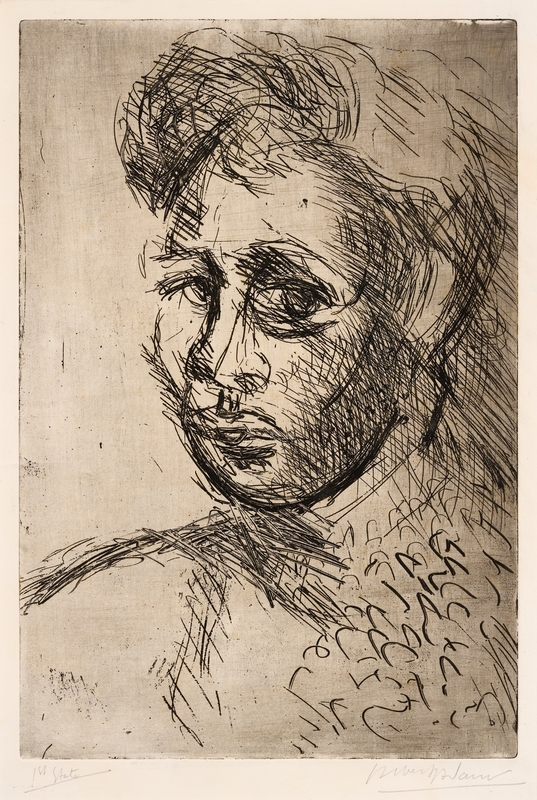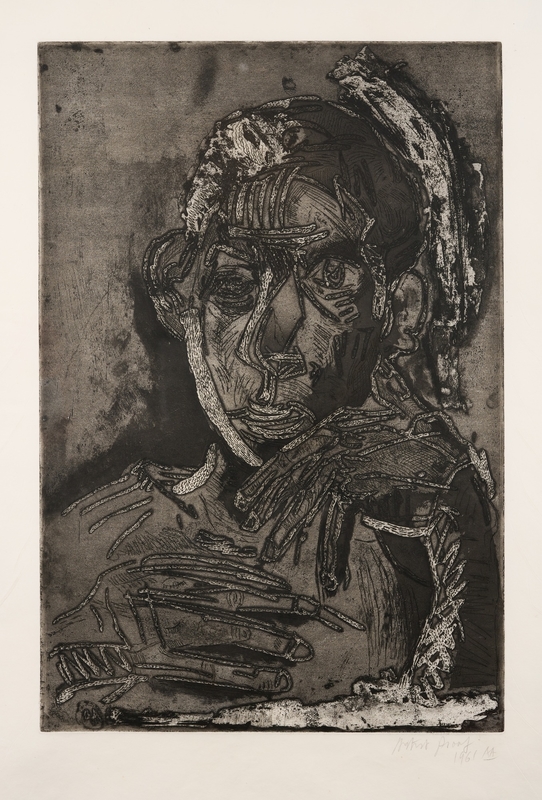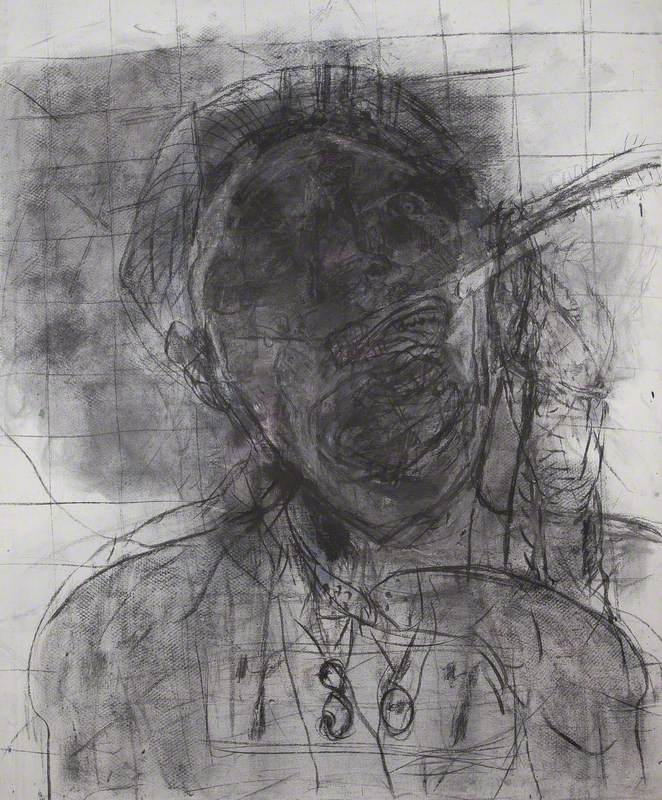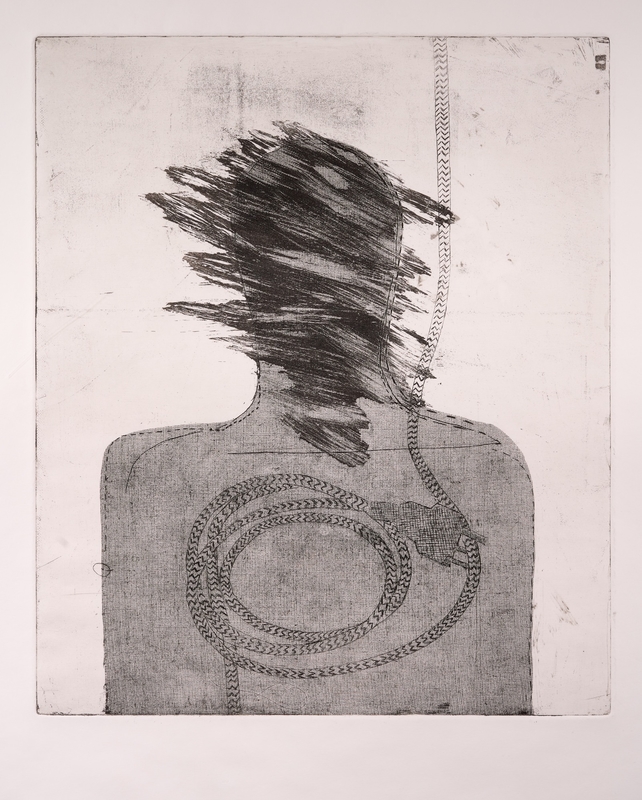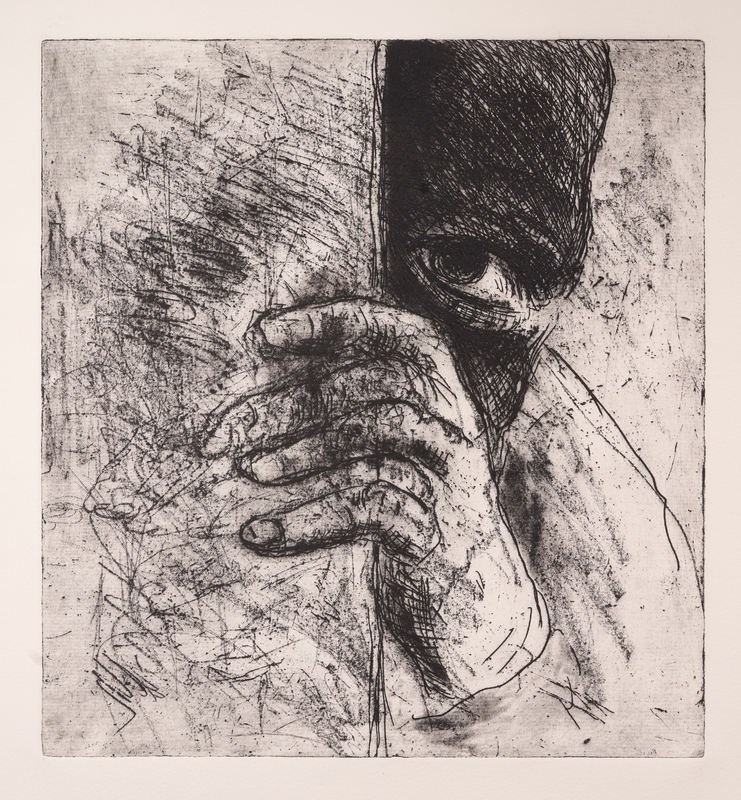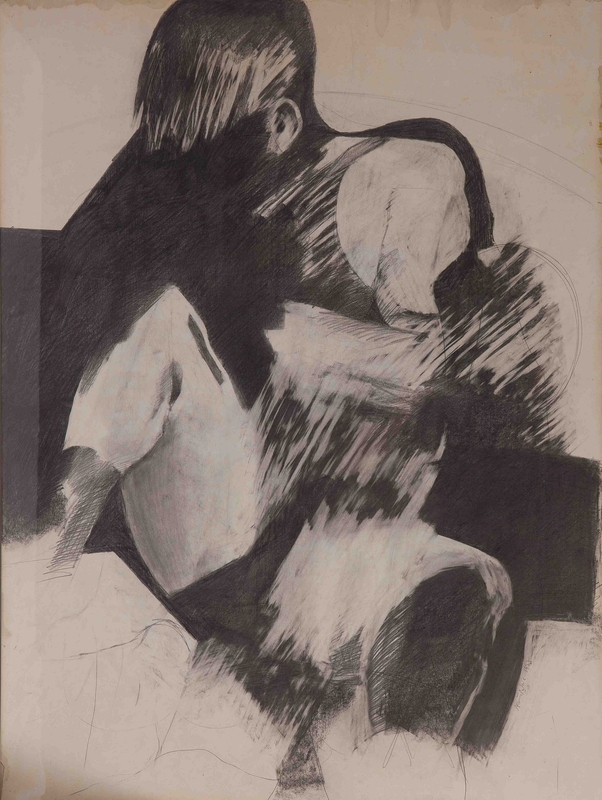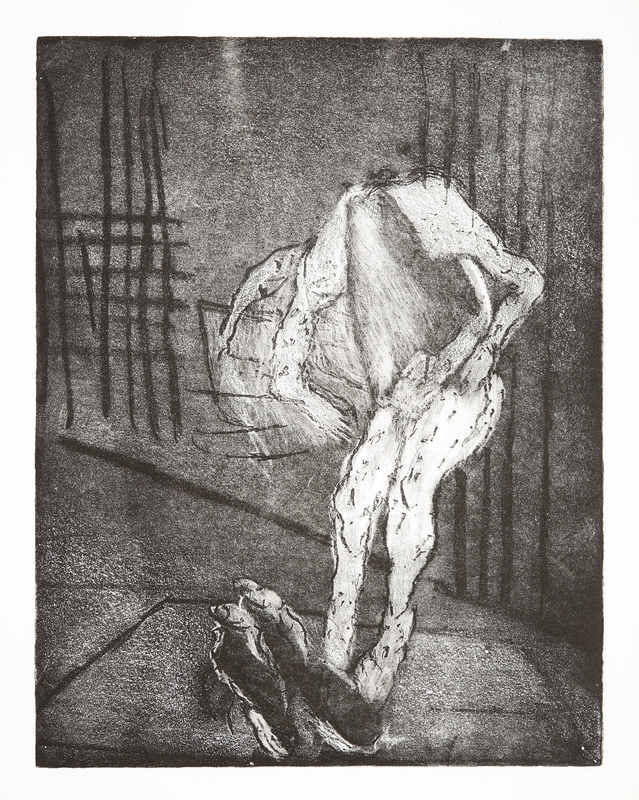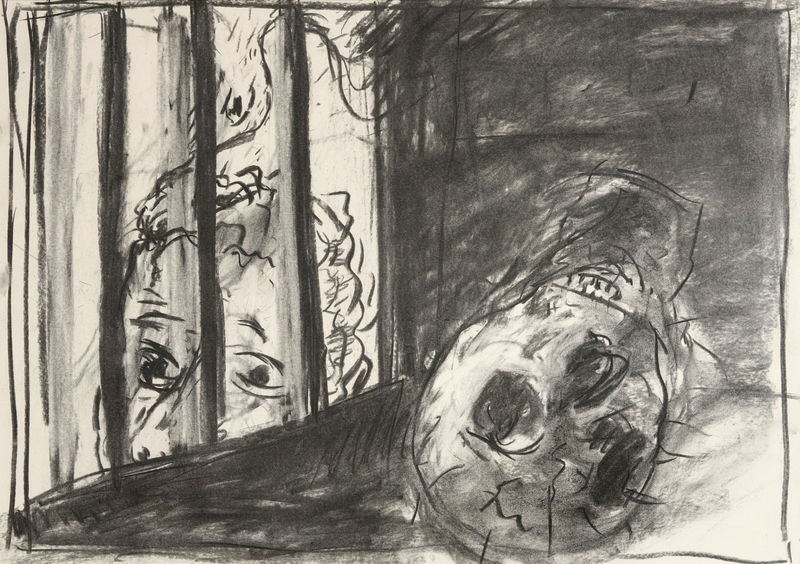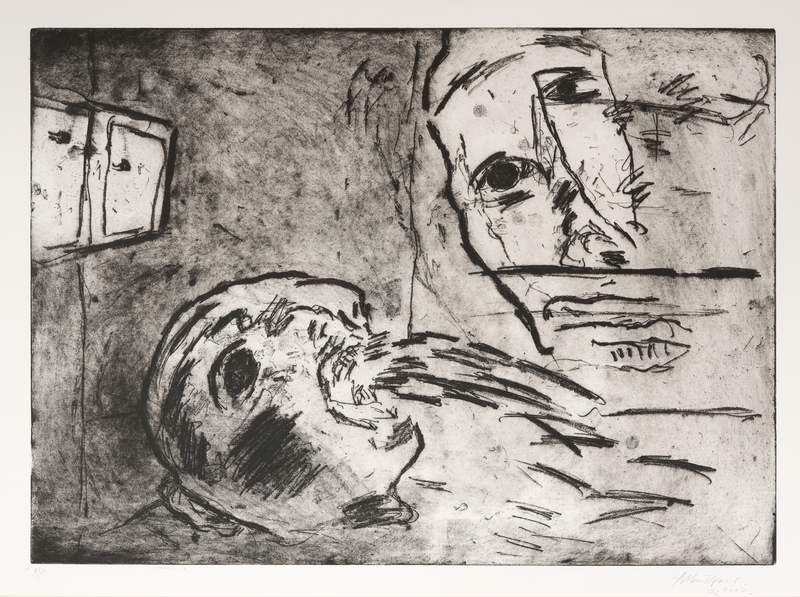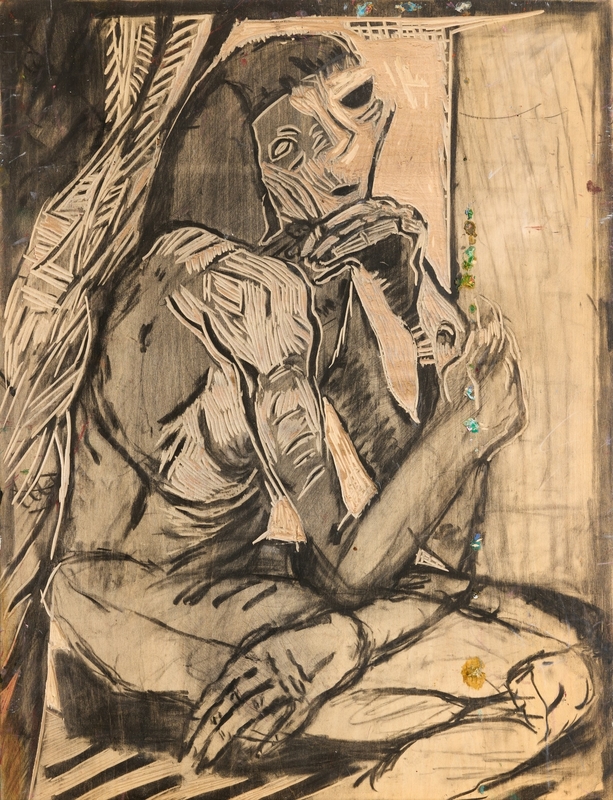Throughout his artistic career, painter and printmaker Albert Adams (1929-2006) sought to confront the realities of human cruelty. He was deeply moved by, and responded to the horrors of war and genocide perpetrated across the world - from South African apartheid to the Iraq War.
Exploring the personal as well as the political, Adams also produced a lifelong series of self portraits, considering his own African-Indian heritage and identity.
This curation reflects the current display of work in the Albert Adams Room, University of Salford, curated by Dr. Alice Correia in 2021. The University of Salford Art Collection holds a substantial body of Adams’ work and archive materials, generously presented by Edward Glennon through the Art Fund.
-
Self Portrait 1956
This self-portrait was made in 1956, the year Adams completed his studies at the Slade School of Art and received a scholarship to attend the Munich Academy of Arts. At the Slade he had been taught by the influential printmaker, Anthony Gross, and this work demonstrates Adams’ experimentation with etching techniques.
Albert Adams (1929–2006)
Drypoint & etching on paper
H 57.5 x W 46.5 cm
University of Salford
-
Albert Adams, Self Portrait (1956), Etching
Etching is a technical and exacting printing process, whereby an image is drawn onto a copper plate with a needle, which is has been dipped in acid for different periods of time to achieve faint and darker lines. This technique enables subtle tonal gradations, and Adams’ image shows how he was testing the strength – darkness and thickness – of his lines, particularly around the chin and nose, while thinner, more delicate lines are used to present his hair. The portrait perhaps shows Adams at a moment of transition, and it is possible to discern a sense of uncertainty or hesitancy in his expression.
-
Self Portrait 1960
Throughout his career, Albert Adams created numerous self-portraits. This work was made in 1960 after he had completed his studies at Munich Academy of Arts (1956-1957) and had attended the School of Vision in Salzburg (1957), run by the celebrated expressionist artist, Oskar Kokoschka. When compared with his earlier Self-Portrait, 1956, this work reveals a looser, more confident handling of line, and a more strident contrast between areas of light and dark. This effect was achieved through Adams’ use of aquatint, an engraving technique, whereby the etching plate is coated in a porous resin, resulting in prints that look like ink-wash drawings.
Albert Adams (1929–2006)
Sugar lift aquatint
H 56.3 x W 38.3 cm
University of Salford
-
Albert Adams, Self Portrait (1960), Sugar lift aquatint print
This work shows the impact of Adams’ studies in Germany and Austria, where he was exposed to German Expressionism, of which Kokoschka was a principle exponent. This style sought to express the artist’s inner emotions, heightening a work’s visual impact by using strong colours or contrasts and distortion. However, discussing Adams’ work from this period, art historian Okwui Enwezor suggested that the artist was engaged not in the replication of a European styles but in the “production of self-awareness”.
-
Although it is unclear when in 1960 this work was made, that year was significant in Adams’ career; he had returned to his native South Africa in the late 1950s but following the Sharpeville Massacre on 21 March 1960, during which the South African police opened fire on a crowd of black protesters and killing 69 people, Adams, like many other black South Africans left the country. In this context, it is possible to view this self-portrait as an assertion of Adams’ identity as a black man.
-
Self Portrait 1961
In this self portrait Adams combines the technique of etching and aquatint, to create an image that is constructed through both drawn line and tonal shading. It presents a close-up depiction of the artist’s head and shoulders; his head is turned slightly, and he looks to his right in contemplation, with his hands raised to his face. The print demonstrates Adams’ increasingly sophisticated engagement with expressionist styles and techniques.
Albert Adams (1929–2006)
Etching & aquatint on paper
H 83 x W 63 cm
University of Salford
-
Albert Adams, Self Portrait (1961), Etching and aquatint
Here he avoids the violence and brutality often associated with expressionism, as seen in the work of British artist Francis Bacon, whom Adams admired, but rather, he conveys a sense of stillness and meditation, that is both poetic and unsentimental. Adams achieved this through his use of tone – light and shade – and his nuanced balance of broad, gestural lines and fine detailing, particularly around the nose and eyes.
-
Celebration Head: Black and White 2003–2004
Celebration Head, 2003, is a large oil and charcoal drawing on canvas and depicts the head and shoulders of a male figure. Despite the optimism suggested by its title, the drawing is a mediation on suffering and pain; the man’s head angled in a jarring expression, and although his facial features are smudged and obscured, it is clear that he is presented with two mouths, both of which are grinning in anguish, teeth bared. Around his neck is a plaque, with the number 7867, reminiscent of prisoner numbers included in police mugshots.
Albert Adams (1929–2006)
Oil & charcoal on canvas
H 138 x W 115 cm
University of Salford
-
Albert Adams, Celebration Head (2003), Oil and charcoal on canvas
The juxtaposition of the man’s suffering and his identification as criminal threat challenges viewers to question their own prejudices and to reflect on the ways mainstream (white) media outlets perpetuate stereotypes of black male criminality.
As part of his Celebration series, 2000-2002, Adams’ drawing can be placed within a larger body of work that addressed the subjugation of the black body in South African culture. Marilyn Martin (Director of Art Collections, Iziko Museums of Cape Town) explained that the Celebration series “referred to post-apartheid South Africa and the challenges, dangers and threats that came with political change”.
-
In this context, Celebration Head seems to caution against too much celebration in the post-apartheid era. His work reminds us that the deep wounds and traumas experienced by generations cannot simply be celebrated away, that past atrocities continue to affect the present.
-
Figure with a Power Cord
Towards the end of the 1970s Adams created several artworks that were indebted to the artist Francis Bacon. Like Bacon, Adams created a series of prints and drawings of (male) figures in enclosed spaces, with brutally distorted features, often crying out in pain. In this work a simplified figure is presented, with their face obliterated in a flurry of aggressive marks. Alongside these violent gestures is a carefully drawn cable, which snakes from the upper edge of the paper down past the head, and coils in concentric circles in front of the figure’s chest, culminated in an electrical plug.
Albert Adams (1929–2006)
Etching on paper
H 73.5 x W 64.5 cm
University of Salford
-
Albert Adams, Figure with a Power Cord (c.1980), Etching
The cable immediately recalls the form of a noose, and the although the torso is still, the vigour of the marks over the face become suggestive of struggle, perhaps the struggle for breath. The title of this work, Figure with Power Cord, is at once banal and menacing, highlighting how the threat of violence can reside in the most quotidian of household objects.
-
The Prisoner (Figure Peering Around A Wall) 1998
This work presents a figure partly positioned behind a wall or doorway. Adams has deftly created a sense of ambiguity in this work: it is not entirely clear whether this is a benevolent figure shielding behind the wall, or a menacing one, lurking. Perhaps the large and swollen fingers provide a clue to the physical damage this person has endured.
Despite having settled permanently in London in 1960, South Africa remained central to Adams’ work; he was moved by and responded to atrocities enacted during his own lifetime and remained acutely aware of continued social and racial injustices.
Albert Adams (1929–2006)
Etching & aquatint
H 53.5 x W 55.5 cm
University of Salford
-
Figure Study 1977
Although an abstracted and distorted image, Figure Study may be regarded as depicting a larger figure holding a smaller child in their arms. The figure of the child lies horizontally across the body of the larger vertical figure. The head of the larger figure is bowed and apart from an ear, no other facial features are given; Instead, the face is shrouded in blackness. The figure’s shoulder is presented as a white circular form, but although seemingly muscular, a thin arm proceeds from it. Although hair on the child’s head is gestured to, again, no facial features are given, with the face instead presented as a black patch. The child’s body is stiff and angular, with its knees drawn upwards.
Albert Adams (1929–2006)
Graphite on paper
W 122 cm
University of Salford
-
Albert Adams, Figure Study (1977), Graphite on paper
Although Albert Adams had lived in London since 1960, he retained close links to South Africa, and it is possible that this work was made in response to the Soweto uprising of 16 June 1976. On that day, an estimated 20,000 black children across South Africa walked out of school, protesting a new law which introduced Afrikaans (regarded by many as a language of apartheid) as a language of educational instruction. The police response to the protest was brutal and many hundreds of children were killed or injured.
-
A photograph by Sam Nzima showing the lifeless body of Hector Pieterson being carried by Mbuyisa Makhubo after being shot by the police was published globally and became an iconic image of the oppression of black people in South Africa.
-
What? and When 2006
Throughout his career Albert Adams preferred to work in series, thinking through his ideas and responses to world events over time. This mode of working resulted in multiple variations on a theme. His series of etchings known as the Incarceration series addressed broad themes of justice and injustice, and Adams explained that “The images themselves were taken from press cuttings, usually of atrocities that were perpetrated in Africa. So although they may seem very grotesque, they were in fact happenings that were real”.
Albert Adams (1929–2006)
Etching
H 76 x W 56 cm
University of Salford
-
Albert Adams, What? and When (2006), Etching
Adams was deeply concerned with presenting the truth of man’s inhumanity, adhering to his tutor Oskar Kokoscha’s assertion that, “We live with closed eyes, not daring to see the misery we create on earth. The task of the artist is to see”.
-
Prisoner, Bird and Skull
Towards the end of the 1990s and into the 2000s, Albert Adams created a series of etchings and charcoal drawings that reflected upon the history of Robben Island and its significance for contemporary South Africa. Three of Albert Adams’ cousins were imprisoned under South Africa’s apartheid laws, and his close friend, linguist and revolutionary, Neville Alexander was held captive on Robben Island from 1964 until 1974. In this charcoal drawing Adams presents a human skull within a darkened cell.
Albert Adams (1929–2006)
Charcoal on paper
H 63.5 x W 80 cm
University of Salford
-
Albert Adams, Prisoner, Bird and Skull (c.1998-2002), Charcoal on paper
Through a series of vertical bars we glimpse the half-concealed face of a young person, with a bird hovering just above their head. The presence of the skull is a devastating reminder of the cost of anti-apartheid struggle, while the bird might be regarded as a symbol of both peace and hope.
-
The Prisoner (Incarceration) 2002
This print presents a decapitated head of a man spewing bile from his open mouth, positioned within an enclosed room. Hovering above the head are two differently sized, overlapping faces. These spectral onlookers show little emotion, regarding the scene in silent stoicism, and act as a point of contrast with the violence and animation of the head below. This work closely relates to an earlier charcoal drawing by Adams, titled Prisoner (Incarceration series) 1999 (private collection) which presents a decapitated head on a clinical table.
Albert Adams (1929–2006)
Etching & aquatint
H 69 x W 84.8 cm
University of Salford
-
Albert Adams, The Prisoner (Incarceration) (2002), Etching and aquatint
As a student in London during the 1950s, Adams had been introduced to the work of British painter Francis Bacon and the influence of Bacon’s celebrated series of screaming heads, which expressed the anxiety and violence of the human condition may be discerned here.
-
Cell (Incarceration) 2002
Cell (Incarceration) depicts a disembodied pair of feet positioned within a dark enclosed space, and below a small square barred window. A hand reaches through the opening into the cell, obscuring a face behind. This is a strange image that at once addresses the terrors of entrapment and the pain of physical violence, while also pointing to the continuance of mental incarceration after freedom has been achieved. Towards the end of his life, Adams reflected that, “My work is based on my experience of South Africa as a vast and terrifying prison, an experience which even now, after a decade of democracy, still haunts me”.
Albert Adams (1929–2006)
Etching & aquatint on paper
H 85 x W 69 cm
University of Salford
-
Figure Study 1955
This woodcut and charcoal panel, titled Figure Study was produced in 1955 when Albert Adams was studying at the Slade School of Art. Although the British art education system underwent considerable change during the 1950s, the Slade remained committed to its founding principles of providing students with a grounding in drawing from life, and competence in representational and figurative painting techniques. During his time at the Slade, Adams would have produced numerous figure studies; what distinguishes this work is his combination of wood cutting – incising lines into the wood - and charcoal drawing.
Albert Adams (1929–2006)
Charcoal on woodcut panel
H 60 x W 45 cm
University of Salford
-
Albert Adams, Figure Study (1955), Charcoal on woodcut panel, oil paint on reverse
It is likely that this work, depicting a gaunt female figure seated aside a drawn-back curtain, is unfinished. The presence of third arm resting across the figure’s lap is suggests that Adams considered different a different compositional arrangement of the figure’s arms.
-
Want to learn more about Albert Adams and his work?
For more information about Albert Adams: In Context, as well as the ongoing Albert Adams project, and the Albert Adams special collection held by the University, you can visit our digital Albert Adams: In Context Resource Room: https://artcollection.salford.ac.uk/albert-adams-in-context/
The Albert Adams: In Context symposium and exhibition is convened by Dr Alice Correia, in collaboration with the University of Salford Art Collection. Supported by the Paul Mellon Centre for Studies in British Art and by a donor funded Salford Advantage Grant.
